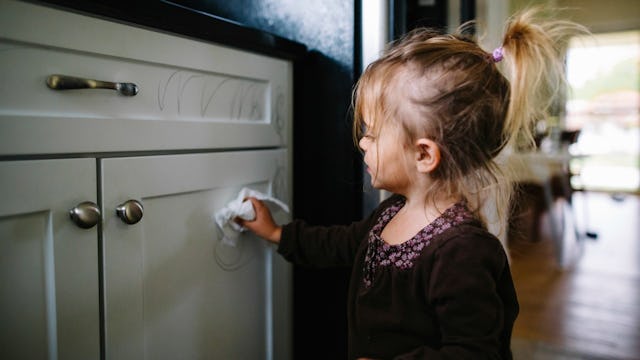Instead Of Forcing Preschoolers To Apologize, We Should Be Doing This Instead

“Say you’re sorry” may teach children to say they’re sorry, but do they know what it means?
Picture this: Your preschooler is playing with another child, there’s a disagreement over who gets to play with a toy and your child pinches the other child, who then starts to cry. What do you do? For many of us, our immediate reaction is to jump in with “Say you’re sorry!” It’s natural. It’s normal. It’s civilized.
But when it comes to children under 5, the reality is, they don’t really know how or why to be sorry, unless we use that moment to teach them what it means.
I’m no stranger to that scenario. It’s been a part of my daily life for more than a decade. First as a preschool teacher and now as an early childhood development researcher specializing in preschoolers (not to mention as a mom to a toddler, so I struggle with the urge to make him apologize daily). However, I’ve found that by going beyond “Say you’re sorry,” I can create a powerful teachable moment to help the children I work with, and my son, understand what an apology is and why it’s important.
How do you do that? Try breaking it into five simple steps:
Step 1: “Get Small”
I quickly get down and make myself small so I’m at their eye level. This helps them better connect with me, listen, and makes them comfortable in an uncomfortable situation. When an adult is standing over them and they get the sense they’re being scolded, they’re more likely to feel embarrassed and shut down. To avoid that, make yourself little, just like they are, and talk in a soft tone.
Step 2: Have Them Identify the Other Person’s Emotion
Since empathy is crucial to understanding what “I’m sorry” truly means, we need to start with the basics, such as emotions. To understand why you’re sorry, a child first needs to understand how the other person is feeling. In the moment, I’ll say something like, “Oh my goodness, look at his face. How does it look to you? Do you think he looks happy?” This works as a great starting point to talk about emotions in context and find a word for the other child’s emotion (sad, scared, upset, hurt, etc) immediately.
Step 3: Talk Through What Happened
Once we talk about what the other child is feeling, I want to get at why they’re feeling that way. Ask something like, “Why do you think they look sad? What were we playing over here that made him feel this way?” This helps children understand that their actions have consequences, and that they affect the way another person feels.
Step 4: Bring It Back to Them
Now that they understand the action that made the other child feel that way, have them put themselves in that child’s position: “How would you feel if they pinched you? Would you be sad?” Then put it into context: “I would never want someone to pinch you and make you feel sad, and I wouldn’t want that for someone else. It is my job to keep everyone safe.” By bringing the event back to them, it personalizes it, and helps them understand how another kid may feel in a given situation.
Step 5: Ask If They Have Something to Say
Rather than forcing an apology, I’ll ask if they have something they might want to say to the other child. If they already understand what an apology is, it usually clicks and they’ll decide themselves to say they’re sorry. If they don’t, offer an explanation like, “You know, sometimes when people do something they don’t mean, or someone hurts someone, they say that they’re sorry to make the other person feel better and let them know it’s not going to happen again.” Then apply it to the situation and ask them again if they have anything they’d like to say. Usually, they’ll apologize, and then I’ll finish by talking through what to do next time instead (like using their words or asking to use the toy when the other child is done).
In the future, try to celebrate the positive behavior with very specific praise when you see them putting it into practice (“I really like how you’re using your words and waiting your turn to play with the toy, that’s how we play nicely together…”). It might seem as though this could take a long time, but in real time, the entire conversation should take one to two minutes. Anything longer won’t hold their attention and could lose impact. You want this to be quick, brief, and understandable for the child.
Making the switch to this approach doesn’t happen overnight. To make it feel natural takes time and practice (and you may have to explain it to other parents along the way who are confused by why you didn’t just immediately make your child say they’re sorry). But I’ve found when put into perspective consistently, even very young children can understand the concept of an apology and will begin changing their behavior.
Working the steps each time, the “sorry” situation can feel repetitive, but by pausing and making “I’m sorry” more than just a reflex, we can help kids become more empathetic and bring meaning to the apology, so they ultimately learn to avoid doing something to be sorry about in the first place and become more mindful about their behavior and how it affects their friends.